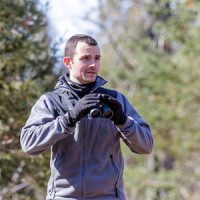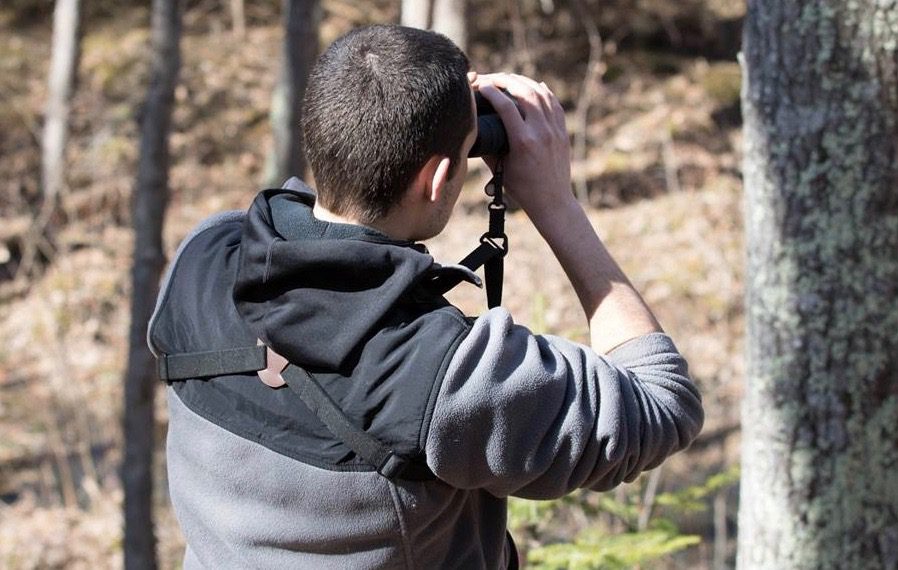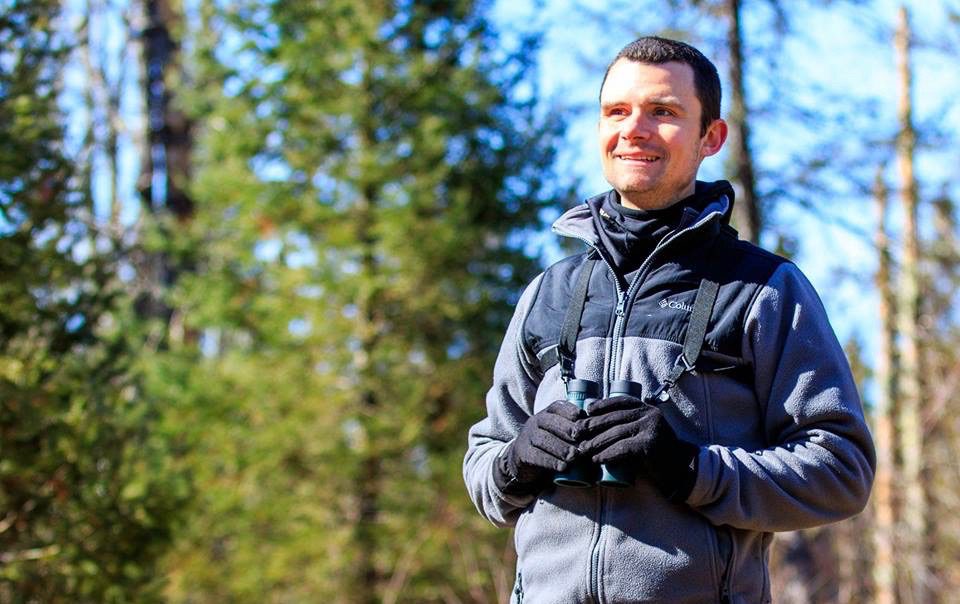We strike out in search of the hermit, but the hermit cannot be found. We look everywhere—in the bog, in the lake, in the sedge grass, between the spruce and the tamarack trees. It’s early spring in Wisconsin, and though my buddy and I aren’t too optimistic about finding the hermit himself—the man died in 1968—we can’t help but make the two-hour drive to Hayward in the hopes of uncovering some small part of him.
We’ve hardly entered the bog before my buddy catches motion out of the corner of his eye. He turns his camera in time to snap a Pine Siskin. Soon, we’ll spot a passing pair of Trumpeter Swans, too, and later, we’ll be graced with eagles. But mostly all we’ll see that day is wilderness—lots and lots of wilderness—all of which seems to have conspired to cover Francis Zirrer’s tracks.
“So…his cabin’s supposed to be where again?” my buddy asks, lowering his camera. “Thirty rods from the nearest road,” I say—a description that does little for those of us who don’t know what a rod is. Nevertheless, it’s the only clue we’ve got, one that came courtesy of conservation biologist and Zirrer scholar Sumner Matteson of the Wisconsin DNR, who, twenty years back, while performing a breeding bird survey, stumbled upon the cabin’s foundation.
“There were some wooden beams on the ground,” he informed me during a recent phone call. “Whether they’re still there, I don’t know. Even if you were to look, I can’t guarantee you’d find anything. The vegetative growth might’ve obscured it.”
Undeterred, my buddy and I wander the lake’s periphery nonetheless, marching through the ankle-deep foliage and trying to avoid the muck.
If nothing else, it’s a nice day for a hike, I think, lowering my expectations. And then, as a courtesy, I lower my buddy’s too.
“You know, we probably won’t find the cabin,” I tell him. “But who knows, maybe we’ll still find something interesting.”
But all we find in the bog that day is nothing—no cabin, no hermit, no signs of human life. Though, in fact, it’s the absence of human life that offers me a different clue to a different question. As the morning progresses I become less interested in where Zirrer had lived, and more interested in what brought him here to begin with.
Why, I wonder, does a man choose to opt out of the world?
As we tromp through the skunk cabbage—the sky alight with birds—I begin to feel as if I’ve found my answer. The air, so crisp, clears the cobwebs from my lungs, and my head, at last, feels uncluttered.
For a moment, the world is filled with silence, right up until my buddy breaks it.
“So if you were a hermit,” he says, “you’d build a cabin here, right?”
I pause to consider the plateau upon which he stands along the water’s edge.
“Sure,” I say at last. “What hermit wouldn’t?”
*
An immigrant from Yugoslavia, Francis Zirrer arrived in America around 1915 or so, and for the next half-century, spent much of his life in the wilds of Wisconsin. His remote locations (first in Rusk County, then Hayward County) provided unfettered access to nature’s grand displays, many of which Zirrer recorded with great poeticism. Such as the return of the bitterns in the springtime, their “ghostly forms” croaking through the night; and the ravens, too, whose wing beats hummed like “an approaching storm” long before he ever saw them.
Yet for all his depictions of the natural world (by which I mean a handful of articles and a pair of newspaper reports), Zirrer left little of himself behind. Most of what we know of him we owe to Passenger Pigeon expert and Wisconsin conservationist A.W. “Bill” Schorger, who, between 1934 and 1949, exchanged letters with Zirrer on a range of topics: ice-gnawing muskrats, tunneling minx, the ripening of hazelnuts. No observation was too small for the curious men, and over time, as their correspondence grew, so too did Zirrer’s paper trail.
While not all their letters survived a great many have, providing insight into the conservation concerns shared between two mid-twentieth century Wisconsinites. In some respects the men couldn’t be more different (Schorger, in Madison, served as city mouse to Zirrer’s country mouse), though their shared affection for nature seemingly allowed their friendship to flourish. Theirs was a symbiotic relationship, one in which each man had something to offer the other. While Schorger undoubtedly provided Zirrer a foothold into the scientific world, Zirrer provided Schorger a foothold into the natural one. From warblers to woodpeckers, Zirrer documented most every creature he encountered, if for no other reason than his own satisfaction and the hope that it might interest his friend.
Yet every nuthatch and Ruffed Grouse would serve as prologue for Zirrer’s most lasting contribution—the discovery of Wisconsin’s first goshawk; the bird that, for better or worse, would forever alter the men’s relationship, as well as their relationship with the wild.
*
My own first goshawk sighting occurs eighty or so years after Zirrer’s. And what I see isn’t even alive, but a specimen in the James Newman Clark Bird Museum in my home of Eau Claire, Wisconsin. She peers at me with marble eyes, her beak pointed menacingly toward me. Even stuffed, I recognize the bird’s regality. Measuring in at nearly two feet tall, her sharp claws lead me to believe she could pluck an entire colony of ice-gnawing muskrats without having to ruffle too many feathers. But goshawks do more than pluck; they cling—driving the unfortunate prey to the ground before killing it. It was a method, Zirrer learned, that the birds were willing to try on humans, too.
According to his letters, Zirrer spotted his first goshawk in the spring of 1933, though initially he remained mum on his finding. While the hermit knew his sighting would be of great interest to the birding community, he also knew he risked both his and the birds’ solitude if he made the sighting public. Yet when the goshawks returned in the spring of 1934, Zirrer couldn’t help but share the news with Owen Gromme, a curator at the Milwaukee Public Museum, as well as the author and artist of the highly acclaimed illustrated guide, Birds of Wisconsin. An early conservationist, Gromme’s interest was indeed sparked by Zirrer’s goshawk claim; so much so that on May 16, 1934, he and his assistant Walter Pelzer completed the 300-mile journey from Milwaukee to Zirrer’s Rusk County cabin.
In his previous day’s field notes, Gromme noted that though they had yet to meet, his brief correspondence with Zirrer had persuaded him that he was a “man of some scientific knowledge,” as well as “a confirmed conservationist.” Later, Gromme would write how “gratifying” it was to meet a man like Zirrer “whose sympathies were with, instead of against the Hawks and who guarded their secret jealousy.” Though some, including Zirrer, might argue that he hadn’t, in fact, guarded their secret jealously enough.
As the museum men entered upon the property, Zirrer attempted hospitality. But it was perhaps a challenge given his general distrust of people, particularly people whom he feared might collect a goshawk specimen for their museum regardless of his preference that they not. This potential difference of opinion was in many ways a microcosm of the era’s shifting views on ornithological study. While many ornithologists and birders still preferred guns to field glasses, as a result of the rise of field guides, the shoot-now-look-later approach had begun to fall out of favor. And for the nature-loving Zirrer, the goshawks were far better use to him roosting in a nearby tree then stuffed and placed on exhibit across the state.
Despite his reservations, Zirrer guided Gromme and Pelzer to a yellow birch tree adjacent to the nest. As the men began assembling their photographic blind, Gromme realized that the branches in the nesting tree obscured their view. Gromme—who perhaps knew better than to take the risk himself—encouraged Pelzer to climb the nesting tree to clear the branches. Pelzer agreed, though he’d barely begun his shimmy up the bough before being attacked by the female goshawk.
Though the tree’s branches obscured the nest, Gromme maintained a front row seat to the action. In his later writings on this moment, Gromme described “the vigorous strokes” of the mother bird’s “powerful wings” and how she “gave her victim a thump on the back that could be heard from some distance.”
Had Pelzer “not been held to the tree by the strong leather belt,” Gromme later wrote, “he most certainly would have been knocked from it…” To Pelzer’s credit, the faithful assistant completed his mission, though upon his return to solid ground, Zirrer noted that Pelzer was said to have “looked with a mixture of sadness and amusement at his shirt, which was hanging in tatters.”
Upon returning to the blind the following week, Gromme endured a similarly brutal attack—making it halfway up the bough before the bird resumed her assault. The pair sparred in the air, Gromme’s swing-and-a-miss soon countered by the goshawk’s direct blow to the intruder’s head. She drew blood, prompting Gromme to descend down the tree, then retreat to a nearby stream to clean his wound.
“From that time on,” Gromme reported, “all ascents into either tree were made with the head well protected by heavy burlap or a sheepskin-lined leather helmet.”
While the attacks were well documented by both Gromme and Zirrer, what remains unclear is how Zirrer himself reacted to the museum men’s pummeling.
Who, I wonder eighty years later, was he rooting for?
*
We’ve all heard the expression: a bird in the hand is worth two in the bush. Yet I imagine Zirrer would’ve preferred the latter option, well aware that a man with a bird in his hand generally meant that bird was dead.
While Zirrer may have had some initial concerns about the museum men’s potential interest in obtaining a specimen, he soon realized that the goshawks’ true threat came from beyond the scientific community.
The following year, when writing of the goshawk to Schorger, he urged his friend to remain mum on the bird’s location.
“I have plenty of reasons for being careful,” he explained cryptically.
In a follow-up letter, he clarified his comment, noting how during Gromme and Pelzer’s visit the previous year, the men had no choice but to take into confidence the property owner upon whose land the birds had nested.
“Consequently the birds were much advertised and bragged about,” Zirrer wrote, “partially due also to the desire of making some money out of it.”
By outing the birds as he had, Zirrer feared he’d inadvertently put a price tag on their backs, particularly for his quick-on-the-trigger neighbors.
The damage had been done, though in an effort to return the goshawks to their anonymity, in the spring of 1935 Zirrer retrieved a long pole and knocked the nest from its perch, hopeful that the birds might retreat deeper into the woods and farther from humankind’s intrusions.
His efforts failed to persuade.
“[T]he hawks had begun to build another nest,” he confessed to Schorger, “not more than sixty to eighty yards from the old one.”
*
In 1935, Zirrer’s relationship with the birds was complicated further when he himself became quick on the trigger, collecting a specimen under the auspices of friendship.
“It was my wish last winter to procure something unusual for you…” Zirrer wrote to Schorger. “So I am sending you one of our baby [goshawks].”
Under other circumstances, the gift of a dead goshawk might have seemed odd, though given Schorger’s insatiable interest in the region’s flora and fauna, Zirrer likely believed the gift an appropriate tribute for a man he greatly admired.
Schorger responded with a generous thank you note, though according to one scholar, his private journal offered a different response.
“[Zirrer] wrote that he wanted to send me something unusual,” Schorger confirmed, “but I am sorry he selected a Goshawk.”
Given the birds’ extreme rarity in the region, the gift of a goshawk indeed seemed a regrettable choice, not only for Schorger, but likely for Zirrer, too. Killing an animal of such majesty, after all, was not something the hermit took lightly.
“It pleases me to know that you are satisfied with it,” Zirrer wrote in his reply to his friend, “as I dislike to destroy such a fine creature, unless there is a perfectly good reason to do so.”
At a loss for what to do with his unusual gift, Schorger donated the goshawk specimen to the University of Wisconsin’s Zoological Museum, which is what brings me to the fourth floor of the L.E. Noland Zoology building last February.
After tromping up four flights of stairs, I’m greeted by Paula Holahan, the university’s curator of mammals and birds.
“You’re the guy interested in the goshawk,” she says.
“Very interested,” I admit.
Paula leads me through the zoology building’s narrow halls until we arrive at a locked door in the building’s interior.
“Here we are,” she says, inserting a key into the door, “the collections room.”
We step inside, at which point we are outnumbered by a seemingly endless array of long-dead specimens. Directly ahead of us, hundreds of bird and waterfowl are cloaked beneath translucent sheets, their webbed feet my only clue to identification. Just beyond them are rows upon rows of metal cabinets, many of which Paula opens for me, informing me of the names of the dead.
Eventually, Paula and I make our way to a nondescript cabinet on the near side of the room. She pulls wide the drawer, revealing a row of goshawks arranged claws to wings like a conga line.
She scans their tags before reaching for one buried a few birds deep.
“Here it is,” she says. “Schorger’s juvenile.”
I’d long thought of it as “Zirrer’s juvenile,” though indeed, the gift was given to Schorger, which technically makes it his.
Though now I am the one receiving it, a specimen that at last makes the men real to me. This is the very bird, after all, that Zirrer sighted, shot, and finally, sent to his pen pal 250 miles away. And it’s the bird that Schorger regretted receiving, the cause of a momentary, one-sided rift between friends. Aside from the letters, it is one of the few items to have passed between them, a bird meant to serve as a gift of goodwill, though the outcome didn’t match the intent.
“Yup. This is Schorger’s tag,” Paula confirms, reading the tiny script scrawled on the inch of paper dangling from the bird’s leg. I lean closer to read the description for myself: “Shot at nest from Francis Zirrer.”
The bird’s death date is recorded just below: June 16, 1935.
In his letter accompanying the specimen, Zirrer recounted the details of the bird’s death: how the goshawk (“about 43 days old”) had been roosting in a branch about seventy feet above the ground when Zirrer aimed his .22 and fired.
Eighty years later, as I stare into its cotton eyes, I’m reminded of all I’ll never know of these men. So far removed from their lives, I’m as blind as the dead bird in the drawer. I can speculate, of course, and I do, crafting a version of truth in which Zirrer didn’t “opt out” of the world as much as demonstrate prudence in establishing his place within it.
Perhaps, I think, Zirrer’s limited interaction with humans was simply the price he paid for a deeper understanding of nature.
Admittedly, it isn’t a price everyone’s willing to pay.
Though Zirrer gave Schorger a goshawk, the greater gift he gave was unfettered access into a world where Schorger, given his other responsibilities, could never quite live fully. For the record, it’s a world where I could never quite live fully, either.
And yet Zirrer lived there on our behalves, offering dispatches from the untouched landscape to those of us who aren’t (or weren’t) willing to live there ourselves. Thanks to Zirrer, I now know the way the Great Blue Heron emerges “like an apparition” before vanishing as if “swallowed up by the creeping fog.” And I know, too, of the “furious bird” we call the Great Horned Owl, who often appears “suspended, though only for a moment, in front of one’s face.”
Yet for all of Zirrer’s observations, no one was observing him. Which, I imagine, is how the hermit preferred it. He, like the Great Horned Owl, was only there for a moment as well.
The world blinked, and we lost sight of him.
*
Three hours into our hike, my buddy stops again.
“How about here?” he asks, nodding to a second plateau near the lake. “Think his cabin was here?”
I’m weary and, admittedly, a bit turned around as the wilderness begins to blur. Suddenly the sedge mat beneath my feet is indistinguishable with the sedge mat beneath my feet fifteen minutes prior. And the trees, just like the trees from before, differ only in their placement. To my untrained eye, this terrain looks the same in all directions, a “sameness” too easily mistaken for abundance, when in fact land like this has shrunken since Zirrer’s time.
I eye the ground, the water, and try to make some sense of it. But there’s not much sense to be made. Zirrer, after all, might’ve lived anywhere in this bog, and since I don’t know how to measure rods from roads, for me, he haunts the whole landscape. It’s almost as if he is the landscape, his echo heard in the flutter of wings and the groans of the trees’ uppermost branches. I can’t help but hear him in the slurping sound the muck makes as it crowds around my boots, can’t help but see him, too, in the tremble of the leather-leaf.
“You know, maybe this is the spot,” I tell my buddy, though of course I can’t be sure.
But even if I did know—and even if I was sure—I like to think I’d guard his secret jealously.
***
Photographs © JW Patchin, 2015.









One response
A beautiful piece on friendship, judgment, wilderness & time. Perhaps Zirrer knew the day that he shot the juvenile Hawk that he was creating a time capsule. Thank you B.J.
Click here to subscribe today and leave your comment.